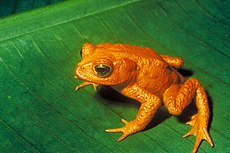
Back Uitsterwing Afrikaans Extinción AN انقراض Arabic انقراض ARZ Estinción AST Nəsil kəsilməsi Azerbaijani نسیل کسیلمهسی AZB Юҡҡа сығыу Bashkir Выміранне Byelorussian Измиране Bulgarian

| Conservation status | |
|---|---|
 | |
| Extinct | |
| Threatened | |
| Lower Risk | |
Other categories | |
| |
Related topics | |
 Comparison of Red list classes above and NatureServe status below  | |
| Part of a series on |
| Evolutionary biology |
|---|
 |
Extinction is when a species of animal, plant, or other organisms are no longer living or dies. Extinction is one of the major features of evolution.[1]
All species become extinct sooner or later. The end of a species may happen for many reasons. It may be caused by habitat loss or by being overhunted, or by a major extinction event. An example of an animal that is now extinct is the Dodo, from over-hunting. Another quite different way for a species to end is by species-splitting, known as cladogenesis. The species living today probably were not living in the Cambrian period, but their ancestors were.
Notable extinct animal species include the non-avian dinosaurs, the saber-toothed cats, the dodo, the mammoths, ground sloths, the thylacine, the trilobites and the golden toad.
Endangered species are those which may become extinct. A report from Kew Gardens suggests that one fifth of plant species may be at risk of extinction.[2] Fossil species sometimes reappear millions of years after they were thought to be extinct. These cases are called Lazarus taxa. Humans are to blame due to cutting down animals’ natural habitat such as forests.